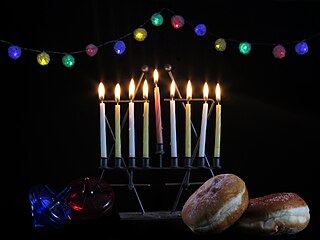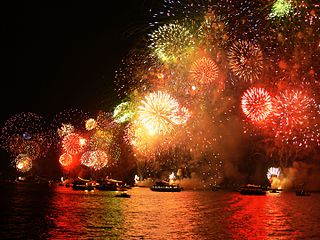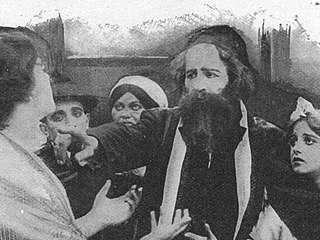
Hanukkah is a Jewish festival commemorating the recovery of Jerusalem and subsequent rededication of the Second Temple at the beginning of the Maccabean Revolt against the Seleucid Empire in the 2nd century BCE.

Jewish holidays, also known as Jewish festivals or Yamim Tovim, are holidays observed by Jews throughout the Hebrew calendar. They include religious, cultural and national elements, derived from three sources: biblical mitzvot ("commandments"), rabbinic mandates, and the history of Judaism and the State of Israel.
Shemini Atzeret is a Jewish holiday. It is celebrated on the 22nd day of the Hebrew month of Tishrei in the Land of Israel, and on the 22nd and 23rd outside the Land, usually coinciding with late September or early October. It directly follows the Jewish festival of Sukkot which is celebrated for seven days, and thus Shemini Atzeret is literally the eighth day. It is a separate—yet connected—holy day devoted to the spiritual aspects of the festival of Sukkot. Part of its duality as a holy day is that it is simultaneously considered to be both connected to Sukkot and also a separate festival in its own right.

In the United States, public holidays are set by federal, state, and local governments and are often observed by closing government offices or giving government employees paid time off. The federal government does not require any private business to close or offer paid time off, as is the case for most state local governments, so employers determine which holidays to observe.

Chrismukkah is a pop-culture portmanteau neologism referring to the merging of the holidays of Christianity's Christmas and Judaism's Hanukkah. It first arose in the German-speaking countries within middle-class Jews of the 19th century. After World War II, Chrismukkah became particularly popular in the United States, but is also celebrated in other countries.

A Hanukkah menorah, or hanukkiah, is a nine-branched candelabrum lit during the eight-day Jewish holiday of Hanukkah. Eight of the nine branches hold lights that symbolize the eight nights of the holiday; on each night, one more light is lit than the previous night, until on the final night all eight branches are ignited. The ninth branch holds a candle, called the shamash, which is used to light the other eight.

Sufganiyah is a round jelly doughnut eaten in Israel and around the world on the Jewish festival of Hanukkah. The doughnut is deep-fried, injected with jam or custard, and then topped with powdered sugar. The doughnut recipe originated in Europe in the 16th century, and by the 19th century was known as a Berliner in Germany. Polish Jews, who called it a ponchik, fried the doughnut in schmaltz rather than lard due to kashrut laws. The ponchik was brought to Israel by Polish Jewish immigrants, where it was renamed the sufganiyah based on the Talmud's description of a "spongy dough".

Bayram is the Turkic word for a nationally-celebrated festival or holiday, applicable to both national and religious celebrations.

Hanukkah gelt, also known as gelt, is money given as presents during the Jewish festival of Hanukkah. It is typically given to children and sometimes teachers, often in conjunction with the game of Dreidel. In the 20th century, candy manufacturers started selling Hanukkah-themed chocolate coins wrapped in gold or silver foil, as a substitute or supplement to real money gifts.
Lists of holidays by various categorizations.

A public menorah is a large menorah displayed publicly during the Jewish holiday of Hanukkah. It is done to celebrate the holiday and publicize the miracle of Hanukkah, and is typically accompanied by a public event during one of the nights of Hanukkah attended by invited dignitaries who are honored with lighting the menorah.

The White House Hanukkah Party is an annual reception held at the White House and hosted by the U.S. President and First Lady to recognize and celebrate the Jewish festival of Hanukkah. The tradition was established in 2001, during the administration of George W. Bush. The guest list includes hundreds of American Jewish politicians, organization heads, and school and yeshiva deans.

A Hanukkah bush is a bush or tree—real or simulated—that some Jewish families in North America display in their homes for the duration of Hanukkah. It may, for all intents and purposes, be a Christmas tree with Jewish-themed ornaments. It is associated with Chrismukkah.

The National Menorah is a large Hanukkah menorah located in the northeast quadrant of The Ellipse near the White House in Washington, D.C. It was first lit in 1979 by President Jimmy Carter, and has been erected and lit every year since. The Menorah has grown in size as well, and is now 30 feet (9.1 m) high.
Sfeka d'yoma is a concept and legal principle in Jewish law which explains why some Jewish holidays are celebrated for one day in the Land of Israel but for two days outside the Land. The implications of sfeka d'yoma are discussed in Rosh Hashanah 21a and in the commentaries and poskim.

Miracle of the cruse of oil, or the Miracle of Hanukkah, is an Aggadah depicted in the Babylonian Talmud as one of the reasons for Hanukkah. In the story, the miracle occurred after the liberation of the Temple in Jerusalem during the Maccabean Revolt, and it describes the finding of a jug of pure oil that was to be enough to light the lamp for one day, but that lasted for eight days.
A Hanukkah film is a genre of film in which the main emphasis is on the celebration of the Jewish holiday of Hanukkah. Films in this style traditionally incorporate the religious aspects of Hanukkah, such as lighting the menorah and the story of the Maccabees, as well as the cultural aspects of Hanukkah, such as spinning dreidels, or eating traditional foods such as latkes, sufganiyot, or gelt. Films in this genre are typically similar to comedy and romantic comedy films in content, however some are similar in style to action, drama, and animated films, among other genres. Hanukkah films are more commonly produced in the United States, however, they are also produced in other countries such as Israel.
Rosh Chodesh L'Banot, also known as Chag HaBanot, and in Arabic as Eid al-Banat, is a holiday celebrated by some Jewish communities in the Middle East on Rosh Chodesh of the Jewish month of Tevet, during the Jewish holiday of Chanukah. The Jewish community where the holiday was most preserved is in Tunisia. But there is also evidence that it was also celebrated in Jewish communities in Libya, Algeria, Kushta, Istanbul, Morocco and Thessaloniki.

Throughout the history of Christianity, Jewish peoples have been historically religious minorities in countries that were majority or even officially Christian. Over time, a unique relationship evolved between the Jews and the major Christian holiday of Christmas, including the creation of separate traditions and the intersection of Hanukkah and Christmas, among other convergences. Some practices perpetuate out of a feeling of otherness, while others are merely lighthearted activities that are accessible when shops are closed around Christmastime.














